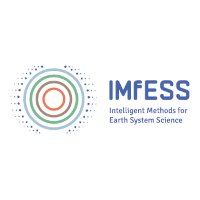Selected projects
The ideas of the key profile area are implemented in numerous individual projects, such as master's theses, whose topics are interdisciplinary and whose supervisors come from different departments.
In addition, the KPA can support projects with its own financial resources.
Master thesis "Graph-based clustering of cloud images"
Due to the influence of different cloud types on the earth's climate and steadily increasing data volume, an automated classification of satellite images of different cloud types is of growing interest. Motivated by this, a new method for clustering cloud images was developed in the interdisciplinary master thesis (computer science and meteorology) of Sebastian Zaun (Institute of Computer Science, AG Prof. Dr. Sohler). Our method divides the input images into smaller square patches to compare the occurrence of different patterns in the different images. In this process, the input images as well as the patches are interpreted as lattice graphs. To perform the clustering of the images, we defined a new distance measure for these images, which is defined by combining an approximation of the graph edit distance and the Wasserstein distance. The former is used to calculate the distance between patches, while the latter is used to compare the occurrence of individual patches in different images. We tested the method on a cloud optical depth image dataset over central Europe.
Master thesis to "Visualization and Visual Analytics"
The interdisciplinary master thesis (Computer Science and Meteorology) from Daniel Braun (Institute of Computer Science, working group Visualisation and Visual Analytics) presents a novel color scheme designed to address the challenge of visualizing data series with large value ranges, where scale transformation provides limited support. We focus on meteorological data, where the presence of large value ranges is common. We apply our approach to meteorological scatterplots, as one of the most common plots used in this domain area. Our approach leverages the numerical representation of mantissa and exponent of the values to guide the design of novel “nested” color schemes, able to emphasize differences between magnitudes.
The whole paper Color Coding of Large Value Ranges Applied to Meteorological Data is here (Arxiv) and the method that is developed and implemented in a python library is here (github).
Dagstuhl Seminar
In Schloss Dagstuhl the Seminar Computational Geometry of Earth System Analysis (23342) takes place from 20 August to 25 August 2023 statt. The organizers are Susanne Crewell (University of Cologne, DE), Anne Driemel (University Bonn, DE) and Jeff M. Phillips (University of Utah - Salt Lake City, US). This Dagstuhl Seminar will bring together computational geometers and meteorologists and will provide a forum to discuss the unique computational challenges that meteorologists are dealing with and how the geometry underlying the input data can be exploited to obtain efficient algorithms. Concrete problem areas that could greatly benefit from synergies between the two research areas include (1) data assimilation of weather-related measurements for numerical simulation, (2) tracking and clustering of moving atmospheric features, and (3) the planning and optimization of sensor placements.
